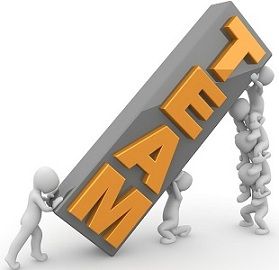 Nowadays, group or team concept is adopted by the organization, to accomplish various client projects. When two or more individuals are classed together either by the organization or out of social needs, it is known as a group. On the other hand, a team is the collection of people, who are linked together to achieve a common objective.
Nowadays, group or team concept is adopted by the organization, to accomplish various client projects. When two or more individuals are classed together either by the organization or out of social needs, it is known as a group. On the other hand, a team is the collection of people, who are linked together to achieve a common objective.
Most of the work in a business entity is performed in groups. Although the individual personality of an employee is important, their effectiveness depends on the teams in which they are working collectively to achieve any objective. In a particular team, there can be several groups in which the group members individually help their leader to accomplish the goals. Below you can see the difference between group and team in an organization, explained in tabular form.
Content: Group Vs Team
Comparison Chart
| Basis for Comparison | Group | Team |
|---|---|---|
| Meaning | A collection of individuals who work together in completing a task. | A group of persons having collective identity joined together, to accomplish a goal. |
| Leadership | Only one leader | More than one |
| Members | Independent | Interdependent |
| Process | Discuss, Decide and Delegate. | Discuss, Decide and Do. |
| Work Products | Individual | Collective |
| Focus on | Accomplishing individual goals. | Accomplishing team goals. |
| Accountability | Individually | Either individually or mutually |
Definition of Group
A group is an assemblage of persons who work, interact and cooperate with one another in achieving a common goal in a specified time. The identity of the group members is taken individually. The members share information and resources with other group members.
In an organisation, the groups are made on the basis of common interests, beliefs, experience in common fields and principles, so that they can easily coordinate with each other. There are two kinds of groups:
- Formal Group: These groups are created by the management of the organisation for performing a specific task.
- Informal Group: The formation of these groups is done naturally in an organisation, to satisfy the social or psychological human needs.
For example: Ethnic groups, trade unions, friendship circles, airline flight crew, etc.
Definition of Team
A group of people who are joined for achieving a common goal within a stipulated period, having collective accountability is known as the team. The agenda of the team is “one for all and all for one”. Apart from sharing information, the team members also share the responsibility of the team task. The team is always responsible for the outcome (i.e. Result of the collective efforts of the team members).
The team members have a mutual understanding with other members. They work jointly to maximise the strengths and minimise the weakness by complementing each other. The most important feature of a team is “synergy” i.e. the team can achieve much more as the members can achieve individually. The three key features of team functioning are:
- Cohesion
- Confrontation
- Collaboration
For example: Cricket team, team for accomplishing a project, team of doctors, management team etc.
Key Differences Between Group and Team
The difference between group and team in the workplace can be drawn clearly on the following grounds:
- There is only one head in a group. A team can have more than one head.
- The group members do not share responsibility, but team members share the responsibility.
- The group focuses on achieving the individual goals. Conversely, the team members focus on achieving the team goals.
- The group produces individual work products. As opposed to, the team who produces collective work products.
- The process of a group is to discuss the problem, then decide and finally delegate the tasks to individual members. On the other hand, a team discusses the problem, then decide the way of solving it and finally do it collectively.
- The group members are independent. Unlike a group, the team members are interdependent.
Video: Group Vs Team
Similarities
- Two or more than two persons.
- Interaction of members.
- Face to face relationship.
- Focus on the achievement of an objective.
- Leader
- Sharing of information and resources
Conclusion
A team is qualitatively different from a group. A team plays a very vital role in the life of the members. The team members as it motivates the members for working creatively and actively participating in the team tasks. Moreover, a team stimulates the members to work for/with one another in an achieving an objective.
The Group is also not less; the group also helps the members in developing a sense of conformity between the members and respect the group values. It increases their resistance to change. Above all, the power of a group is always more than an individual.






Tadesse megersa says
nice shot, I got a lot of lessons
Abdullah Khan says
Excellent Explanation…
Mercy Tening says
I enjoyed the explanations. Thanks
Anjum says
Good shot with simple explanation 👍
Dr. H. M. Dekate says
Nicely explained.
Dr. Bhavesh Chandrakant Bhuptani says
Very Different style of explanation.
Abui Daniel chrispo says
The required documents are satisfactory, update me with references
Abui Daniel chrispo says
Good and sammarize
SHANTHASHEELA,KAYARKANNI,NIRMALA. says
Excellent Experience Thank You
JEEVA RANI THANGAM GANDHI says
very informative. simple and clear
Muhammad Minhazur Rahman says
A nice illustration!
Noor-ul-sehar says
Very informative
Rumina parveen says
Thanks for stepping up and getting this done for us.
Eyasu Dessalegn says
Eyasu Dssalegne
July 12 2022
Thanks for teaching us!
Shahed Alsawadi says
It was interesting reading about it.
Could you please give an example for a group.
Rogers 47 says
Beautiful explanation , straight forward and informational
Kierontreac says
Good article but no references.
alana says
I learnt a lot from this:)
George Lightroller says
Thanks for the information and would it be possible to have references to the information provided?
Marmaduke Ethanol says
Is this all your work or are there any references? But either way a great read.
Abby says
Very informative, thank you!
Maybe add references though?
123 says
hello, its useful information
arrom says
Thank you for helping me with my research, it was very useful with my college work.
Dr.Rajshri Dharmadhikari says
Nice content, well expalined.
thanu perera says
thank you so mcuh.
Ronaldo Okello says
Thank you so much for the knowledge.
Barbara Ama Woode says
I enjoyed reading it, well explained.
Thank you
Austin says
Was great thanks
Filippos says
thank you